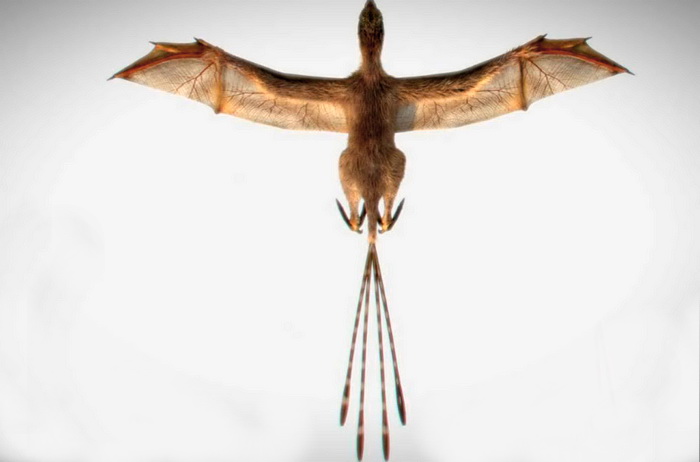An 'old bat' has opened an interesting counter resolution – dinosaur bat. Robert provided the links to https://crev.info/2019/05/dinosaur-bat-wings/ and https://uk.reuters.com/article/us-science-dinosaur/-bat-winged-dinosaur-… … a Jurassic dinosaur flew with bat like membrane wings. The image below was released from the Institute of Vertebrate Paleontology and Paleoanthropology at the Chinese Academy of Sciences. The membrane like wings were made of skin and supported by a long pointed wrist bone – totally differening from the feathered wings of birds (which are thought to have evolved from the dinosaurs). However, we are also told the wings are not too unlike those of pterosaurs (flying repltiles), or the wings of bats (which are mammals). Bats first appear in the fossil record around 50 million years ago (or post-K/T boundary event).
 … This is of course another example of the extraordinay survival of soft tissue in the Chinese bone bed currently under excavation. It has given rise in the first link to a trifle of scepticism – to say the least. The author of the piece says they are bats – old bats. These are bats he says and not dinosaurs – even if they were found in a Jurassic sedimentary layer. He puts in an interesting argument on the idea the world is much younger than mainstream allows. However, I don't see a problem in describing it as a dinosaur as it clearly preceded the age of mammals (although some dimunitive mammals have been found in Jurassic rocks). The age of mammals began after the K/T boundary event which wiped out a large part of the former species, including the dinosaurs. The bat like dinosaur, or reptile, filled a niche in the environment, one that in the mammalian era is filled by modern bats. Bats are rodents with wings one might argue, and squirrels rodents with tails (being unkind). Bats resemble the rodent family and we know they existed in the dinosaur era – and apparently survived to live another day (their offspring going forth to populate the earth, one might say). Mammals expanded after the K/T boundary event and went on to fill niches in the environment formerly filled by animals such as the bat like dinosaur. Another example is the dolphin, which appears to have filled the niche once taken by the Ichthyosaur. Ichthyosaurs also disappeared at the K/T boundary event. Darwin was able to show that finches evolved to fill several different niches in the environment – after an initial colonisation of the Galapagos by a pair of finches (or a group of finches). One can see that rodents that survived the K/T boundary event were equally able to fill a number of niches – and specialise in feeding habits and so on. The K/T boundary event represents the end of the dinosaur and reptile ascendancy and the beginning of mammalian domination of the animal world. The survivors lived in a species poor environment but quickly recolonised the different habitats. The fossil record can be read as a series of catastrophic events (preserving in rocks the animals that died) suggesting punctuated evolution rather than a straight off Darwinian model – but this idea has been around for some time.
… This is of course another example of the extraordinay survival of soft tissue in the Chinese bone bed currently under excavation. It has given rise in the first link to a trifle of scepticism – to say the least. The author of the piece says they are bats – old bats. These are bats he says and not dinosaurs – even if they were found in a Jurassic sedimentary layer. He puts in an interesting argument on the idea the world is much younger than mainstream allows. However, I don't see a problem in describing it as a dinosaur as it clearly preceded the age of mammals (although some dimunitive mammals have been found in Jurassic rocks). The age of mammals began after the K/T boundary event which wiped out a large part of the former species, including the dinosaurs. The bat like dinosaur, or reptile, filled a niche in the environment, one that in the mammalian era is filled by modern bats. Bats are rodents with wings one might argue, and squirrels rodents with tails (being unkind). Bats resemble the rodent family and we know they existed in the dinosaur era – and apparently survived to live another day (their offspring going forth to populate the earth, one might say). Mammals expanded after the K/T boundary event and went on to fill niches in the environment formerly filled by animals such as the bat like dinosaur. Another example is the dolphin, which appears to have filled the niche once taken by the Ichthyosaur. Ichthyosaurs also disappeared at the K/T boundary event. Darwin was able to show that finches evolved to fill several different niches in the environment – after an initial colonisation of the Galapagos by a pair of finches (or a group of finches). One can see that rodents that survived the K/T boundary event were equally able to fill a number of niches – and specialise in feeding habits and so on. The K/T boundary event represents the end of the dinosaur and reptile ascendancy and the beginning of mammalian domination of the animal world. The survivors lived in a species poor environment but quickly recolonised the different habitats. The fossil record can be read as a series of catastrophic events (preserving in rocks the animals that died) suggesting punctuated evolution rather than a straight off Darwinian model – but this idea has been around for some time.
